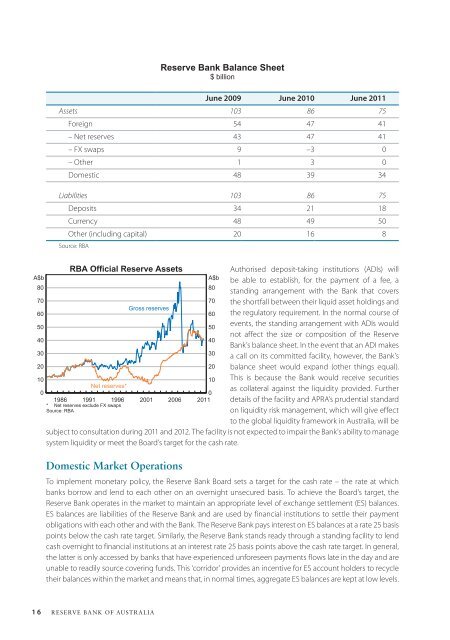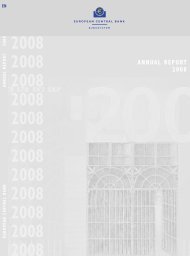Reserve Bank of Australia Annual Report 2011
Reserve Bank of Australia Annual Report 2011
Reserve Bank of Australia Annual Report 2011
You also want an ePaper? Increase the reach of your titles
YUMPU automatically turns print PDFs into web optimized ePapers that Google loves.
<strong>Reserve</strong> <strong>Bank</strong> Balance Sheet<br />
$ billion<br />
June 2009 June 2010 June <strong>2011</strong><br />
Assets 103 86 75<br />
Foreign 54 47 41<br />
– Net reserves 43 47 41<br />
– FX swaps 9 –3 0<br />
– Other 1 3 0<br />
Domestic 48 39 34<br />
Liabilities 103 86 75<br />
Deposits 34 21 18<br />
Currency 48 49 50<br />
Other (including capital) 20 16 8<br />
Source: RBA<br />
A$b<br />
80<br />
70<br />
60<br />
50<br />
40<br />
30<br />
20<br />
10<br />
0<br />
RBA Official <strong>Reserve</strong> Assets<br />
Net reserves*<br />
1986 1991 1996<br />
* Net reserves exclude FX swaps<br />
Source: RBA<br />
Gross reserves<br />
2001<br />
2006<br />
80<br />
70<br />
60<br />
50<br />
40<br />
30<br />
20<br />
10<br />
0<br />
<strong>2011</strong><br />
A$b<br />
Authorised deposit-taking institutions (ADIs) will<br />
be able to establish, for the payment <strong>of</strong> a fee, a<br />
standing arrangement with the <strong>Bank</strong> that covers<br />
the shortfall between their liquid asset holdings and<br />
the regulatory requirement. In the normal course <strong>of</strong><br />
events, the standing arrangement with ADIs would<br />
not affect the size or composition <strong>of</strong> the <strong>Reserve</strong><br />
<strong>Bank</strong>’s balance sheet. In the event that an ADI makes<br />
a call on its committed facility, however, the <strong>Bank</strong>’s<br />
balance sheet would expand (other things equal).<br />
This is because the <strong>Bank</strong> would receive securities<br />
as collateral against the liquidity provided. Further<br />
details <strong>of</strong> the facility and APRA’s prudential standard<br />
on liquidity risk management, which will give effect<br />
to the global liquidity framework in <strong>Australia</strong>, will be<br />
subject to consultation during <strong>2011</strong> and 2012. The facility is not expected to impair the <strong>Bank</strong>’s ability to manage<br />
system liquidity or meet the Board’s target for the cash rate.<br />
Domestic Market Operations<br />
To implement monetary policy, the <strong>Reserve</strong> <strong>Bank</strong> Board sets a target for the cash rate – the rate at which<br />
banks borrow and lend to each other on an overnight unsecured basis. To achieve the Board’s target, the<br />
<strong>Reserve</strong> <strong>Bank</strong> operates in the market to maintain an appropriate level <strong>of</strong> exchange settlement (ES) balances.<br />
ES balances are liabilities <strong>of</strong> the <strong>Reserve</strong> <strong>Bank</strong> and are used by financial institutions to settle their payment<br />
obligations with each other and with the <strong>Bank</strong>. The <strong>Reserve</strong> <strong>Bank</strong> pays interest on ES balances at a rate 25 basis<br />
points below the cash rate target. Similarly, the <strong>Reserve</strong> <strong>Bank</strong> stands ready through a standing facility to lend<br />
cash overnight to financial institutions at an interest rate 25 basis points above the cash rate target. In general,<br />
the latter is only accessed by banks that have experienced unforeseen payments flows late in the day and are<br />
unable to readily source covering funds. This ‘corridor’ provides an incentive for ES account holders to recycle<br />
their balances within the market and means that, in normal times, aggregate ES balances are kept at low levels.<br />
16 <strong>Reserve</strong> bank <strong>of</strong> <strong>Australia</strong>





![KNOW YOUR NEW GIBRALTAR BANKNOTES - [Home] bThe/b](https://img.yumpu.com/50890985/1/184x260/know-your-new-gibraltar-banknotes-home-bthe-b.jpg?quality=85)
![PAPUA NEW GUINEA - [Home] - Polymer Bank Notes of the World](https://img.yumpu.com/49758743/1/190x143/papua-new-guinea-home-polymer-bank-notes-of-the-world.jpg?quality=85)










